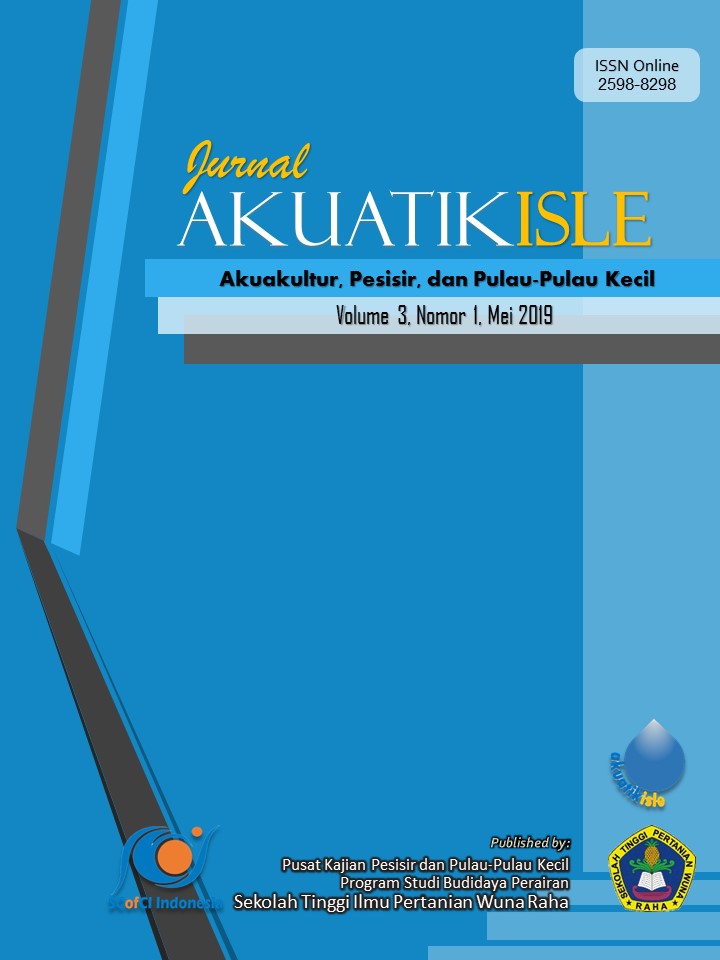Akuatikisle: Jurnal Akuakultur, Pesisir dan Pulau-Pulau Kecil
Full Length Article
Effect of temperature and density on the survival rate of transportation nener milkfish Chanos chanos
Highlights
Generate NLP AI by Wizdam ID.
Abstract
The study aims to determine the optimum temperature, optimum density and optimum temperature and density interactions in milkfish (Chanos chanos) transportation. This research was conducted in 2016, in Kendari City, Southeast Sulawesi Province. This study uses a factorial design, consisting of Temperature and Density Factors. The design of the combination treatment of Temperature (A) namely Temperature 15 oC, A2 Temperature 18 oC, A3 Temperature 21 oC. For Density Factor (B), B1 Density of 600 individuals / container, B2 Density of 800 individuals / container, B3 Density of 1,000 individuals / container. The results of analysis of variance at 95% and 99% confidence level, the treatment in this study had no significant effect, where the F count is smaller than the F table. This shows that the combination of temperature and density tested in this study can be used for energy transportation activities for 14 hours. Based on the percentage of graduation of nener life tested in the transportation, starting from the biggest graduation to the smallest life pass, is a combination of 15 oC temperature treatment and a density of 1000 individuals 95.57%, a combination of 18 oC temperature treatment and a density of 800 individuals 95.04 %, a combination of temperature treatment of 21 oC and density of 1000 individuals 91.70%, combination of temperature treatment of 15 oC and density of 800 individuals 90.04%, combination of temperature treatment of 15 oC and density of 600 individuals 89.89%, combination of temperature treatment of 21 oC and a density of 800 individuals 88.67%, a combination of temperature treatment 18 oC and a density of 1000 individuals 88.07%, a combination of temperature treatment 21 oC and a density of 600 individuals 84.33% and a combination of temperature treatment 18 oC and density of 600 individuals 73.28%.
Keywords
Introduction
Section snippets
Material and Methods
Materials and methods from the full-text PDF of this article cannot be displayed.
Results
Results from the full-text PDF of this article cannot be displayed.
Discussion
Discussion from the full-text PDF of this article cannot be displayed.
Conclusions
Conclusions from the full-text PDF of this article cannot be displayed.
Acknowledgment
Acknowledgment from the full-text PDF of this article cannot be displayed.
Funding Information
Kementerian Riset, Teknologi, dan Pendidikan Tinggi, Republik Indonesia
Competing interest
The authors declare that they have no known competing financial interests or personal relationships that could have appeared to influence the work reported in this paper.
Conflict of interest
The authors declare that the research was conducted in the absence of any commercial or financial relationships that could be construed as a potential conflict of interest.
Ethical approval acknowledgements
No ethical approval required for this article. All procedures followed were in accordance with the ethical standards of the responsible committee on human experimentation (institutional and national) and with the Helsinki Declaration of 1975, as revised in 2008 (5)
Supplementary files
Data sharing not applicable to this article as no datasets were generated or analysed during the current study, and/or contains supplementary material, which is available to authorized users.
Bibliographic Information
Cite this article as:
-
Submitted
10 January 2019 -
Revised
26 April 2019 -
Accepted
10 May 2019 -
Published
12 May 2019 -
Version of record
20 May 2019 -
Issue date
31 May 2019
Keywords
Copyright
Copyright © 2019 Muhammad Bakri, Wa Ode Nurlin, Fendi. Sangia Research Media and Publishing. Production and hosting by Sangia (SRM™).  This work is licensed under a Creative Commons Attribution-ShareAlike 4.0 International License.
This work is licensed under a Creative Commons Attribution-ShareAlike 4.0 International License.
Disclaimer: All claims expressed in this article are solely those of the authors and do not necessarily represent those of their affiliated organizations, or those of the publisher, the editors and the reviewers. Any product that may be evaluated in this article or claim that may be made by its manufacturer is not guaranteed or endorsed by the publisher.
Comments on this article
By submitting a comment you agree to abide by our Terms and Community Guidelines. If you find something abusive or that does not comply with our terms or guidelines please flag it as inappropriate.


